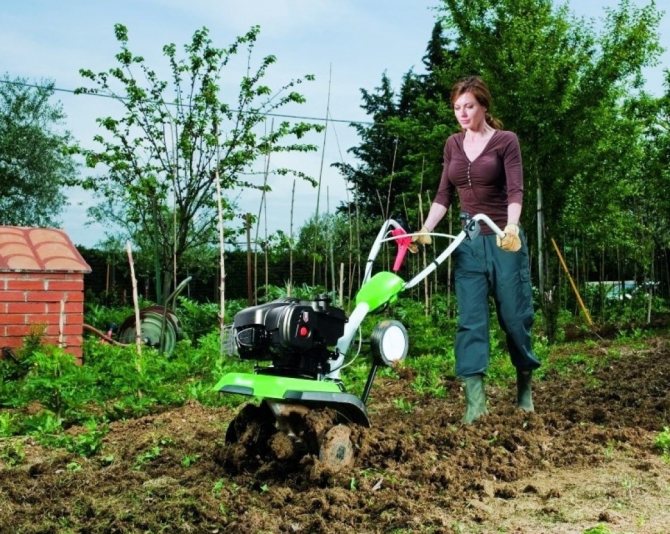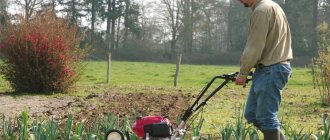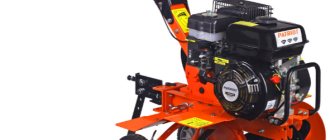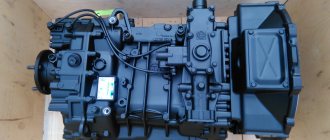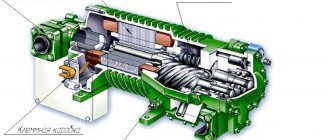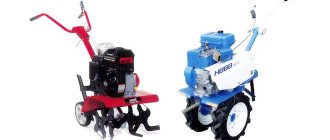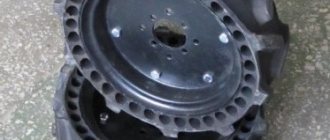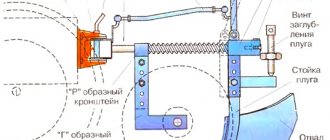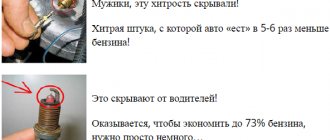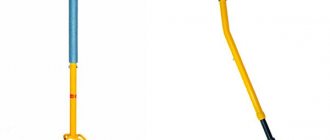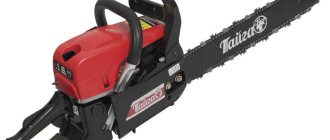Tips for choosing an electric cultivator
The cultivator is a hand-held garden unit that does an excellent job of weeding, loosening the soil and removing weeds. The models on the market differ in weight, power, processing area and number of cutters. It is also necessary to pay attention to the additional functions of the model, for example, the presence of a cutter speed controller, with which you can select the optimal operating mode.
When choosing an electric cultivator for your dacha, take into account the type of soil to be processed, the features, topography and area of the site, as well as the nature of the planned work. For example, compact models with good maneuverability are best suited for loosening flower beds in the country. In addition, the owner will not have to pay for excess power.
Do-it-yourself dacha
Let us remind you that in the new year the Daewoo company presented its second development. This is an electric cultivator. It has attachments, as well as an adjustment mechanism that allows you to adjust the width of the treated area. The model is called Daewoo DAT 2500E - it is a classic type model. It is equipped with high-quality and modern devices and parts that work economically and very efficiently.
This model is unique of its kind. This is one of the species that demonstrates the best performance. It is worth noting that the previous model of the DAT 2000 E cultivator also had the ability to mount attachments, but its power was low, which did not allow it to process all types of soil.
The Daewoo DAT 2500E electric cultivator has an induction motor. It has a large motor resource. Torque increased. This means that Daewoo DAT 2500E electric cultivators can handle the most difficult areas. The Daewoo company initially pays great attention to the types of engines that it produces.
Selecting a model based on technical characteristics
Let's look at the features and differences of electric cultivators according to their main characteristics - weight, drive power, area and depth of processing, as well as the type and number of cutters.
Weight, power and processing area
Depending on the weight of the device, electric cultivators are divided into three groups - ultra-light, light, medium. The drive power and processing area depend on the value of this indicator:
- Ultra-light - mini-cultivators, weighing up to 10 kg and drive power up to 1000 Watts. Due to their compact size and good maneuverability, they are excellent at cultivating light soil in flower beds, greenhouses and row spacing. The working width does not exceed 30 cm.
- Lightweight - models weighing up to 20 kg and a power of no more than 1.5 kW. The processing width reaches 40 cm. Such devices are designed for processing pre-plowed land in dachas with an area of 8-10 acres.
- Medium - weighing up to 50 kg and an electric motor of 2-2.5 kW. Productive models for areas with difficult soil with an area of more than 10 acres. They are distinguished by reliability and endurance. The average width of land coverage is 50 cm.
" Note! The absence of heavy models is due to the low power of the electric drive. If your site requires a machine weighing more than 50 kg, you should consider purchasing a powerful motor cultivator equipped with a gasoline internal combustion engine.”
Milling cutters
The number and speed of rotation of cutters affect the productivity of work. The number of knives for tillage varies between 2-6, depending on the type of model. On light models, the rotation speed of the cutters is higher, which compensates for the lack of weight.
The design of knives can be solid or collapsible. The second option is preferable, since models with removable cutters are much easier and cheaper to maintain.
Hand cultivator
The simplest type of country tool is a hand cultivator. Its use in the garden allows you to loosen the soil, and in the most inaccessible places, for example, between rows, near fences, in greenhouses and greenhouses, without affecting neighboring plants. The main advantage is high maneuverability, mobility and low cost.
Even a child can handle a hand-held compact cultivator. Despite the ease of labor, using these models still requires some effort to process the soil. The unit is not intended for heavy, uncultivated land, can only be used in small areas, and has low productivity.
Electric or gasoline cultivator?
Cultivators can be equipped with either internal combustion engines running on gasoline or an electric drive. In some cases, powerful motor cultivators are required for work, but sometimes it is enough to use a small unit - manual or electric.
Pros and cons of an electric cultivator
Compared to gasoline cultivators, models with electric drives have the following advantages:
- Ease of use - no need to adjust the carburetor, adjust the accelerator and constantly monitor the fuel level;
- Ease of maintenance - for uninterrupted operation at the dacha, it is enough to regularly lubricate the moving parts and follow the rules for changing the oil or belt in the gearbox;
- Low costs – paying electricity bills is cheaper than purchasing fuels and lubricants;
- Compact size, good maneuverability and low noise level during operation;
- No harmful emissions that pollute the atmosphere.
Along with the advantages, there are a number of disadvantages:
- The range of the device is limited by the length of the cord for connecting to the power source. There are battery-powered cultivators on the market that do not have this drawback, but they are characterized by low power and short operating time. Please note that the battery life does not exceed 200 cycles.
- Low productivity - for virgin soil it is better to purchase a motor cultivator, since even the most powerful electric models are designed for cultivating light soil.
- Most models are not designed for the installation of auxiliary attachments, which limits the functionality of the devices;
- Dependence on weather conditions - the electric cultivator cannot be used during rain, due to the risk of electric shock.
Advantages and disadvantages
Like any other equipment, electric cultivators have both positive and negative sides. Over time, weaknesses are worked out and with newer models something is constantly changing. The advantages of this technique include:
- Compactness is very important, because the electric cultivator needs to be transported, and it is much easier to work with light equipment. A lot of attention was paid to this factor; many metal parts were replaced with plastic ones.
- Ease of operation - this factor directly depends on the first one. The manufacturer does everything possible to ensure that anyone can work with electric cultivators, regardless of size and age.
- Environmental Safety. If previously such equipment worked on gasoline engines, now preference is given to electric models powered by the network. Thanks to this power supply, you can continue working without taking breaks to refuel. In addition, work without gasoline fumes is especially welcome in greenhouses.
- Easy to maintain. In order to carry out maintenance work, it is enough to change the oil on time, lubricate the main components and thoroughly clean the cutter every time after work.
- Rare breakdowns.
- Low noise level - especially for lightweight models. During operation, you can hardly hear the engine running.
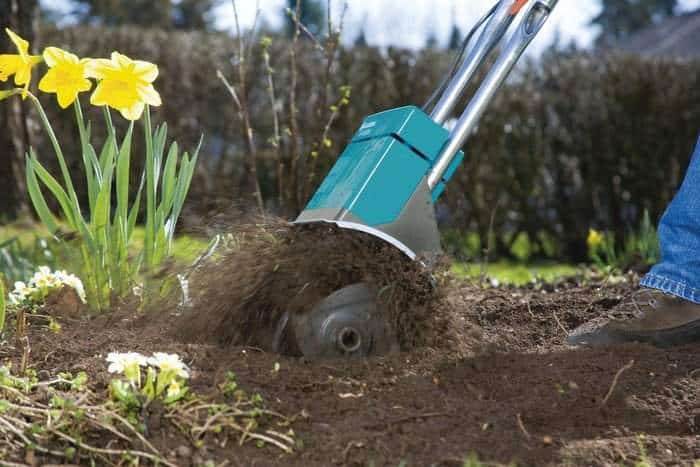
The existing disadvantages include the following:
- Limitation of work area by cable length. If you need to treat an area located a little further from the house, then it becomes necessary to carry a portable extension cord with you.
- The low engine power makes plowing, for example, areas with compacted soil problematic.
- There is a dependence on the power outlet; if the power is turned off, then plowing becomes impossible.
Safety precautions when working with an electric cultivator
Modern models of electric cultivators for summer cottages are distinguished by their high safety performance. However, neglecting the operating rules can lead to dire consequences.
We present a number of basic requirements that must be observed when using an electric cultivator:
- Store the device in a dry place;
- Before starting work, inspect the cultivator for damage;
- Do not use cables with damaged insulation;
A complete list of requirements for safe work performance is contained in the user manual.
What to look for when choosing
In order to purchase a convenient and inexpensive hand-held cultivator for the garden, which is most suitable for the conditions of its use, it is necessary to determine the scope of application and the necessary characteristics of the device and, based on this, select a motor cultivator with the closest parameters. This way you can save money on purchasing equipment and significantly improve the quality of land cultivation.
Power
The performance of the cultivator will depend on the power of the motor, which directly affects its ability to cultivate an area of soil of a certain size to the required depth.
The larger the area of the site, the more powerful the cultivator engine should be. Otherwise, you risk violating regulatory operating conditions, which will significantly reduce the service life of the cultivator.
For a small area (less than 15 acres), for example, a summer house, a small garden or a vegetable garden with greenhouses, lightweight, inexpensive models of cultivators with a power of up to 4 hp, designed for short distances, are suitable. For cultivating large areas (more than 100 acres), cultivators with a motor of 6 to 9 horsepower are designed, leaving deep furrows.
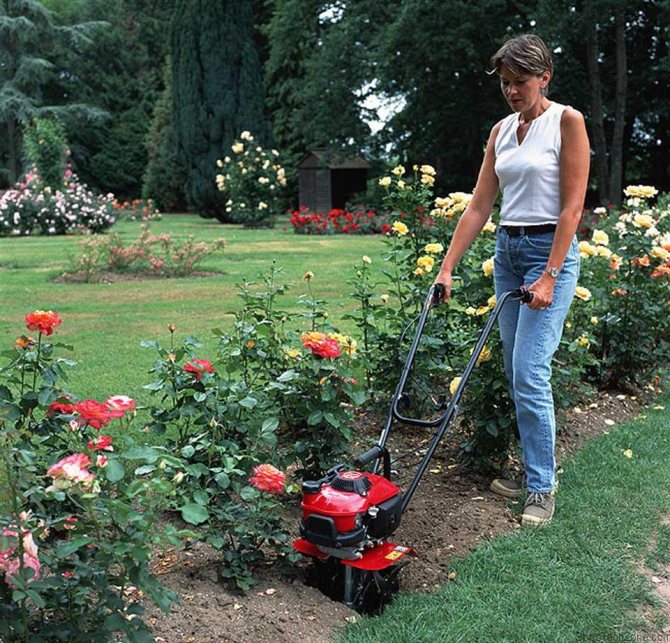
Keep in mind that the purpose of the device and how productive the cultivator is will determine the cost of the device, which will allow you to significantly save money when purchasing.
Plowing width
The width of plowing when cultivating a plot with a cultivator should also be determined by the area of the cultivated plot. So, for an area of less than 15 acres, a cutter with a grip width of 60 cm is suitable, for an area of 15 to 60 acres - 80 cm, and for large areas (more than one hectare) - it is better to choose a cutter with a maximum grip of 90 cm.
Plowing depth
Depending on the condition of the soil at the dacha, as well as the nature of the planned work, the weight of the cultivator and the depth of plowing of the soil are selected. The type of cultivator you need depends on the land. Processing virgin soil, where there are a lot of plants, or heavy clay soil is possible only with heavy gasoline units, while ultra-light electric models are suitable for flower beds and beds in the country.
Number of speeds
The ability to change the speed of operating equipment affects the number of areas of its application. Thus, the heavier the equipment, the more complex the energy transfer mechanism it is equipped with. This, in turn, allows you to change the productivity of the cultivator and ensure smooth adjustment of its operating modes, depending on its complexity and volume.
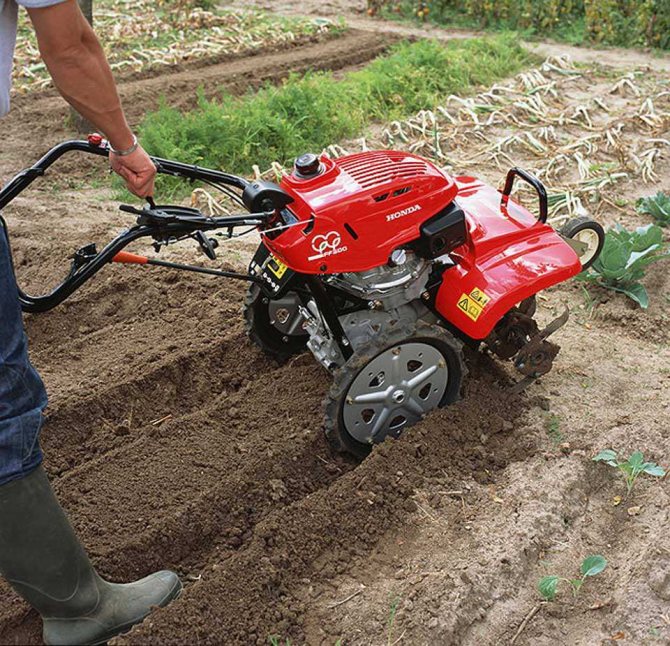
Thus, the more similar and easier the task assigned to the cultivator, the less speed it will need.
Weight
The weight of the device directly depends on its power, productivity, and plowing depth. That is, the larger the area of the plot and the more difficult the nature of the work on it, the heavier the unit required for processing the garden. However, keep in mind that the greater the weight of the cultivator, the more difficult it is to transport, control, and also the higher the fuel consumption.
Rating of electric cultivators
Let's consider the rating of the best electric cultivators for summer cottages, compiled based on reviews from owners.
Inexpensive models
Champion EC750

| Power (hp) | 1,02 |
| Milling cutter speed (rpm) | 380 |
| Gearbox | Worm |
| Plowing width (mm) | 320 |
| Plowing depth (mm) | 110 |
| Weight, kg) | 7,2 |
A compact and lightweight model that even the elderly can handle. It is distinguished by maneuverability and ease of transportation.
Judging by the reviews, the main drawback for owners of dachas and gardens is considered to be non-removable knives, which are very inconvenient to clean after finishing work.
DDE ET1200-40
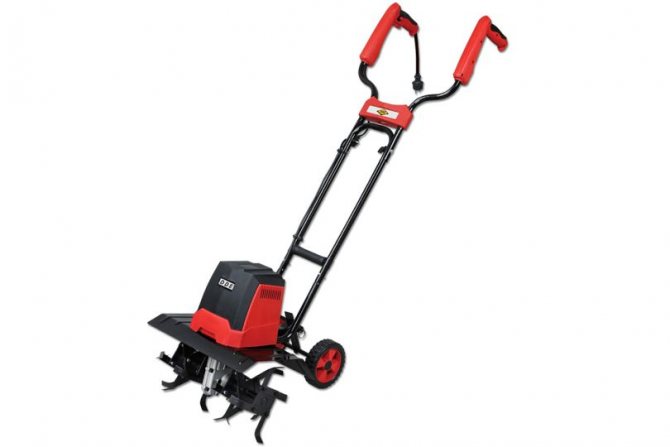
| Power (hp) | 1,6 |
| Milling cutter speed (rpm) | 300 |
| Gearbox | Worm |
| Plowing width (mm) | 400 |
| Plowing depth (mm) | 110 |
| Weight, kg) | 12 |
A reliable and popular device, equipped with wheels for transportation and an adjustable handle. Will cope well with the treatment of plowed beds and greenhouses.
According to reviews from owners, the cultivator gearbox is quite capricious and requires careful attention.
Patriot Tesla 3
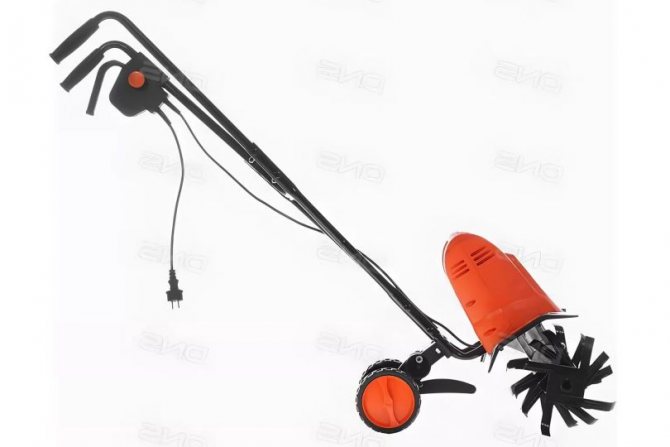
| Power (hp) | 1,9 |
| Milling cutter speed (rpm) | 140 |
| Gearbox | Worm |
| Plowing width (mm) | 400 |
| Plowing depth (mm) | 110 |
| Weight, kg) | 15,5 |
Small-sized model with support wheels, characterized by low noise level. Thanks to the folding handle, the device will not take up much space during transportation. The cultivator perfectly loosens pre-cultivated soil.
If you believe the reviews, the start button is located inconveniently - you have to turn on the device with both hands.
Middle segment
Daewoo Power Products DAT 1800E
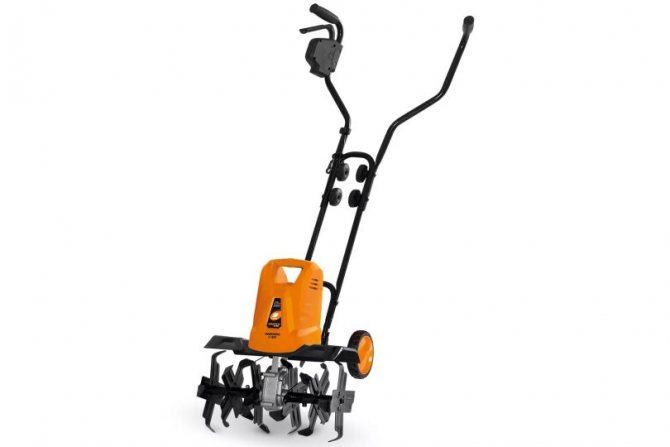
| Power (hp) | 2,38 |
| Milling cutter speed (rpm) | 140 |
| Gearbox | Gear |
| Plowing width (mm) | 400 |
| Plowing depth (mm) | 115 |
| Weight, kg) | 13,3 |
A special feature of the cultivator is its housing, which is protected from dust and moisture. The folding handle makes it easy to store and transport the device. The coulter and 24 specially shaped cutters ensure high-quality plowing of the land in the country.
Negative reviews draw attention to the shallow loosening depth, which is incomparable with the power of the cultivator.
Elitech KB 4 E
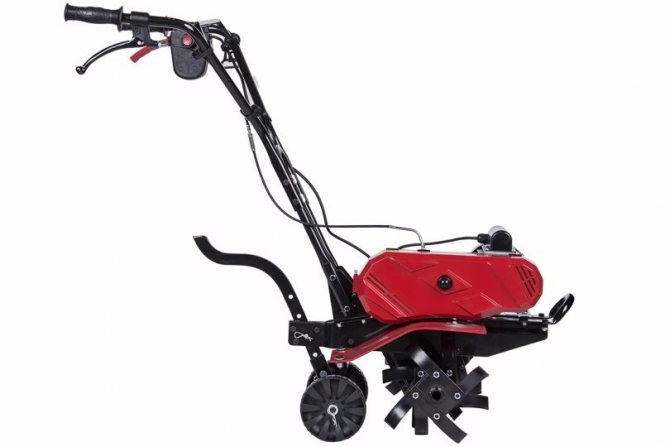
| Power (hp) | 2,71 |
| Milling cutter speed (rpm) | 140 |
| Gearbox | Chain |
| Plowing width (mm) | 450 |
| Plowing depth (mm) | 150 |
| Weight, kg) | 32 |
A single-speed electric cultivator that goes deep into the ground on its own, requiring no effort from the operator. Rubberized handles and well-placed controls increase operating comfort. The model is designed for soil cultivation in small vegetable gardens, greenhouses and greenhouses.
In reviews, users indicate that the only drawback of the model is its heavy weight.
Greenworks GTL9526
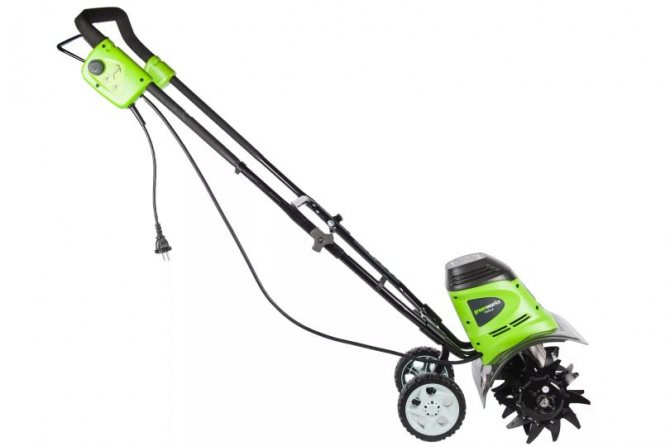
| Power (hp) | 1,3 |
| Milling cutter speed (rpm) | 320 |
| Gearbox | Worm |
| Plowing width (mm) | 260 |
| Plowing depth (mm) | 195 |
| Weight, kg) | 12,1 |
A device with self-deepening, designed for loosening the soil in hard-to-reach places and weeding between rows. Support wheels and a folding handle simplify the process of operation and transportation. There is a built-in fuse against accidental activation.
In some reviews, owners write that the device heats up very quickly, which shortens the period of useful operation.
Dear segment
Eurosystems La Zappa 1300 W

| Power (hp) | 1,77 |
| Milling cutter speed (rpm) | 120 |
| Gearbox | Worm |
| Plowing width (mm) | 320 |
| Plowing depth (mm) | 150 |
| Weight, kg) | 23 |
A high-quality cultivator designed for cultivating summer cottages and vegetable gardens with an area of up to 300 m2. Users note good handling and low noise levels. Suitable for processing light and medium soils.
In some reviews there are references to the weak design of the stop.
Hyundai T 2000E
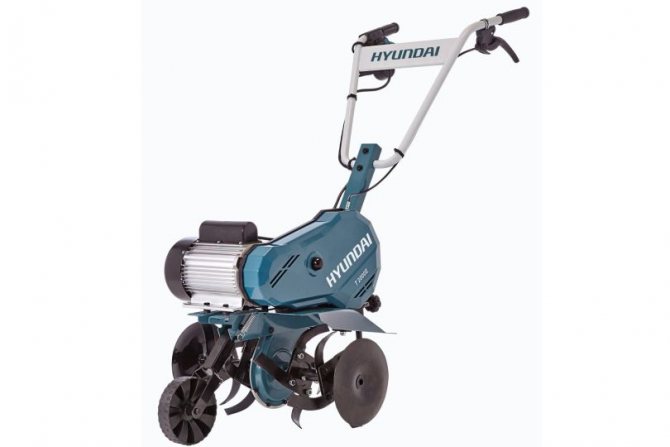
| Power (hp) | 2,4 |
| Milling cutter speed (rpm) | 120 |
| Gearbox | Chain |
| Plowing width (mm) | 450 |
| Plowing depth (mm) | 260 |
| Weight, kg) | 29,8 |
Productive electric cultivator with built-in protection against accidental starting. The handle is height adjustable in 4 positions, adapting to the height of the operator. The presence of side edgers eliminates the possibility of damage to plants in the country. There is also a reinforced coulter with smooth adjustment of the working depth.
It is suitable for processing medium and complex soils, but it will not cope with virgin soil - there is not enough power.
Daewoo Power Products DAT 2500E
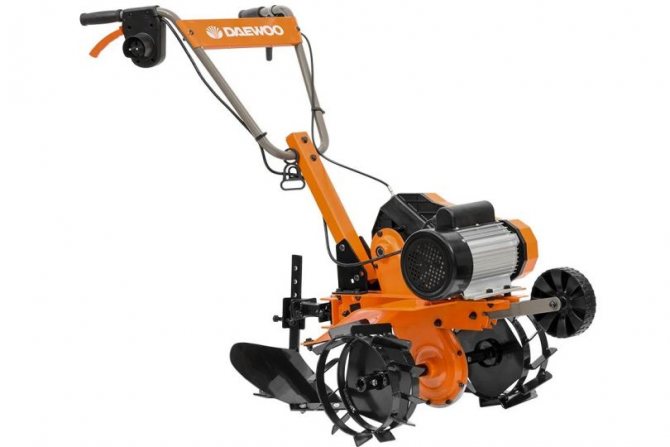
| Power (hp) | 3,4 |
| Milling cutter speed (rpm) | 165 |
| Gearbox | Chain |
| Plowing width (mm) | 550 |
| Plowing depth (mm) | 280 |
| Weight, kg) | 30,25 |
A powerful model with a reinforced coulter and transport wheels of increased diameter that easily overcome obstacles and uneven surfaces. The reliable asynchronous motor practically does not heat up during operation. The cultivator is distinguished by its quality. The guaranteed service life of the chain reducer is 100 years.
Judging by the reviews, some owners of the device had difficulties during assembly due to incomplete information in the instructions from the manufacturer.
The most powerful
Daewoo Power Products DAT 2000E
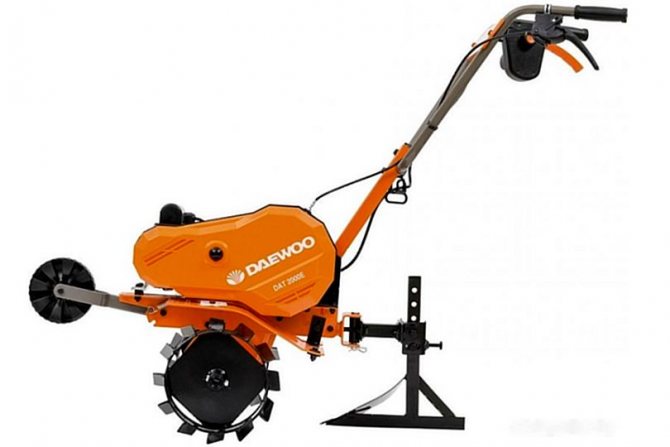
| Power (hp) | 2,71 |
| Milling cutter speed (rpm) | 360 |
| Gearbox | Worm |
| Plowing width (mm) | 400 |
| Plowing depth (mm) | 230 |
| Weight, kg) | 12,23 |
An excellent cultivator that combines compact size and efficient operation. The model is distinguished by its build quality. Forged cutters cope well with both light and clay soils.
The reviews write that the standard cord is not enough for normal operation - you need to purchase an extension cord.
Hammer EC1500
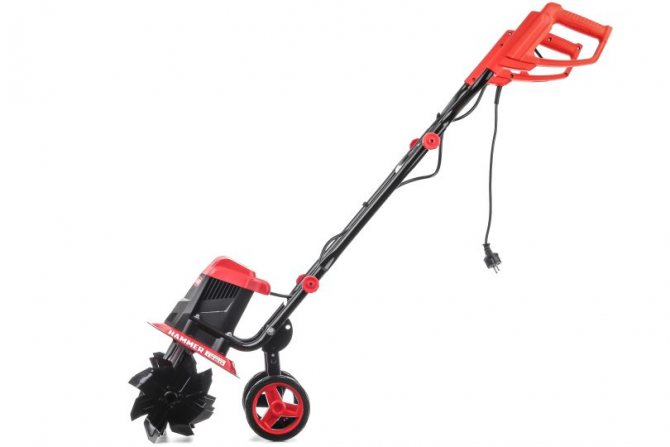
| Power (hp) | 2,0 |
| Milling cutter speed (rpm) | 200 |
| Gearbox | Worm |
| Plowing width (mm) | 400 |
| Plowing depth (mm) | 220 |
| Weight, kg) | 11,6 |
A lightweight cultivator that can be operated even by older people. Thanks to the ergonomic design of the handles, you can work with the device for a long time with minimal effort. There is a built-in vibration suppression mechanism.
In some reviews, owners complain about loud noise during operation.
Zigzag ET 214
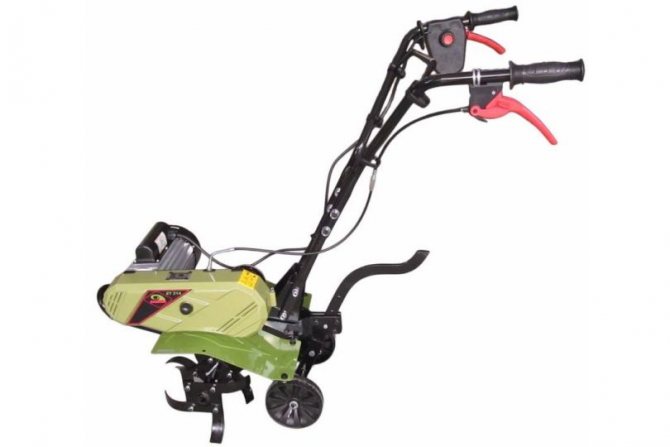
| Power (hp) | 2,86 |
| Milling cutter speed (rpm) | 140 |
| Gearbox | Chain |
| Plowing width (mm) | 450 |
| Plowing depth (mm) | 200 |
| Weight, kg) | 32 |
A powerful electric cultivator designed for processing large areas, up to 20 acres. The engine is enclosed in an aluminum housing with fins for effective heat dissipation during operation. Suitable for all types of soil, including virgin summer cottages.
If you believe the reviews, the instructions from the manufacturer are not clear - some owners had difficulties assembling the device.
Classification
How to choose a cultivator? Models of equipment for cultivating land differ from each other in various technical characteristics, which determine not only the productivity and reliability of the equipment, but also its cost.
Depending on the purpose of the cultivator, there are fallow models, which are used before sowing crops, and row-crop models, which are necessary after germination.
By drive type
Depending on the presence or absence of a power unit, cultivators are divided into:
- Mechanical with manual drive, in which the main driving force is human physical effort;
- Mechanized with a power unit that independently drives the working parts of the cultivator;
- Aggregate, which are a variant of attachments that receive energy through the tractor power take-off shaft.
By engine type
As a power unit, almost all cultivators use two engine options - electric or gasoline. In this case, the electric unit is used in light models, and the gasoline unit is intended for heavy equipment capable of digging up heavy clay soil or virgin soil, where there are a lot of roots.
Electrical devices are favored by higher environmental friendliness, low operating costs, as well as simplicity of design and compactness. In turn, a gasoline cultivator, which produces more exhaust gases and heat, is more mobile and productive.
By weight and power
The main gradation for agricultural machinery is its power and weight characteristics. Thus, electric and manual cultivators are divided into:
- Ultralight small cultivators. The simplest and, as a result, the cheapest models, designed for processing small areas, weighing up to 35 kg and motor power up to 5 horsepower, or, in electric versions, up to 1.5 kW. Lightweight equipment has a minimum of functions beyond standard processing of beds. You can choose a motor cultivator of this type for cultivating a vegetable garden at a shallow depth, for plowing the soil in a greenhouse or on a lawn. An inexpensive cultivator can make furrows in garden beds, capture the roots of weeds, and some models are equipped with an attachment for root crops. The hiller can be disk or plowshare;
- The second, lightweight group of compact hand cultivators is equipped with motors up to 6.5 hp and also weighs up to 60 kg. With their help, you can perform the same list of work as on the lightest models, but with the ability to use an additional list of convenient attachments for processing the garden, including a furrow plow, a hiller for root crops and a mower for working with lawns;
- The average line of cultivators is characterized by an engine power of up to 7 “horses” and a weight of up to 90 kg. As a rule, the convenient disk drive of such cultivators provides the ability to control speed, which allows you to further expand the list of attachments and possible soil cultivation work. Cultivators are intended for gardens, industrial greenhouses, as well as snow removal, transporting heavy loads over short distances and pumping liquids (like a pump);
- Heavy models of cultivators weigh more than 90 kg and have a power of up to 9 hp. Such motor cultivators are equipped exclusively with gear transmissions, which prolongs the service life of the mechanisms and makes speed control more convenient. Also, a number of lightweight devices and attachments can be additionally connected to equipment of this class through a special shaft, the operation of which occurs independently of the main mechanism. It is better to purchase a heavy cultivator for long distances and industrial beds.
